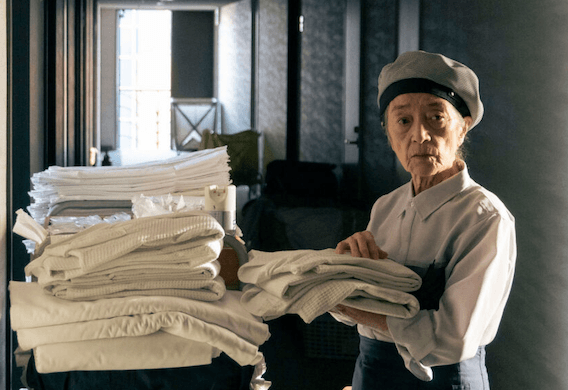Is Government-Sanctioned Euthanasia Really That Hard To Imagine?
One unsettling aspect of Chie Hayakawa’s ‘Plan 75’ is the business-as-usual quality of the imagined bureaucracy set up to deal with the citizens willing to end their lives for the greater good.

The most unnerving thing about “Plan 75,” the debut feature from Japanese filmmaker Chie Hayakawa, is that the dystopian future it presents doesn’t seem futuristic at all. This is as true for the film’s mise en scène as it is for its premise.
There’s no comfort to be taken, for instance, in city-states that have been reimagined as gleaming high-tech playlands or blighted urban hell-scapes. We are far removed from either “Logan’s Run” or “Soylent Green,” iconic 1970s movies that “Plan 75” brings to mind. What the picture does share with these two schlock masterpieces is summed up in the title: an agenda and time.
In “Logan’s Run,” you’ll recall, an Edenic world is built upon a duplicitous conceit — the mandatory murder of its citizens upon their reaching 30 years of age. Utopia, in distinct contrast, is unimaginable in “Soylent Green,” wherein New York City in the year 2022 — yes, that particular sell-by date has passed — is lacking in space and food. As a consequence, senior citizens can opt for a trip to the Thanatorium, an assisted suicide clinic run by the government.
The Japan we see in “Plan 75” is rather ordinary, if considerably dour: Cinematographer Hideho Urata swathes almost the entirety of the movie in a steely gray. Overpopulation has become so dire that the government has instituted a voluntary program, Plan 75, that allows seniors to end their own lives for the greater good.
Current-day Japan does have one of the oldest populations in the world and the government, with an eye on trimming budgetary fat, has encouraged delayed retirement for its seniors. When Ms. Hayakawa was doing research for her film, she floated its premise to a group of elderly women from various social strata. To a person, each respondent said that if a Plan 75 did exist, they would submit to it in order not to be a burden to their families and to the culture at large.
Another unnerving aspect of Ms. Hayakawa’s film is the business-as-usual quality of the imagined bureaucracy that deals with government-sanctioned euthanasia. The advertising, the outreach, the incentives, and the amiable young people manning the front desks and working the phone lines — the professionalization of death is given a benign face. There is nothing that can’t be marketed in a positive light. A dour strain of satire wheedles its way through “Plan 75.”
At the center of the film is Michi (Chieko Baishō), a 78-year-old woman who has lost her job, received notice that her home will soon be undergoing demolition, and whose best friend recently died. Having little in the way of savings and no family, Michi begins to waver on Plan 75, an option she has previously resisted entertaining. Alongside Michi’s travails, we follow two younger characters: Himoru (Hayato Isomura), a recruiting agent who begins to doubt the moral basis of government-sponsored euthanasia, and Maria (Stephanie Arianne), a young Filipino care-giver eager to make some extra income to take care of her sick daughter.
Over the run of “Plan 75,” Ms. Hayakawa proves adept at composition and eliciting nuanced performances from her cast, but is somewhat iffier as a storyteller. The shape of the film proves unwieldy, as the three separate plot lines are allowed to meander too long before they begin to hint at a common dramatic purpose. By the time we reach the denouement, the picture has fizzled in momentum.
An editor with a firmer hand might’ve righted this ship. In the meantime, “Plan 75” touches upon a bevy of home truths with enough deftness to make it worth your while.

